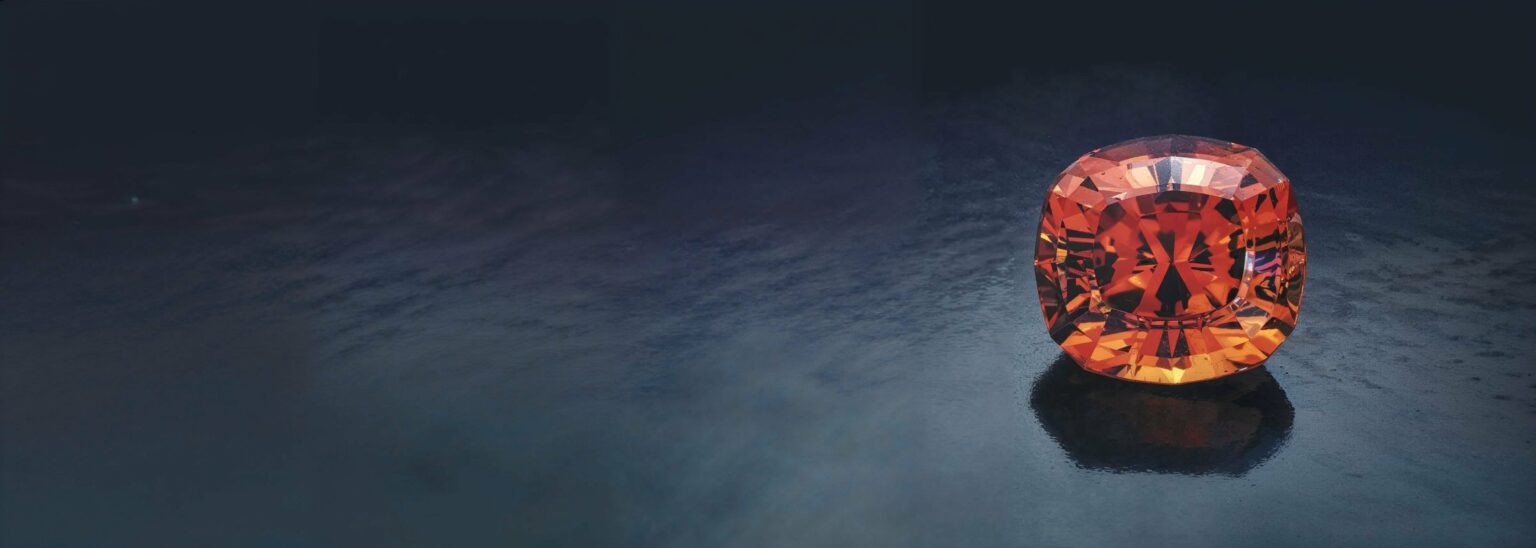It has been more than four years since Louis Spaulding Jr. last found a mineral specimen or gem rough of consequence at America’s only full-time spessartite garnet mine in Ramona, Calif., near San Diego. Still known as the Little Three Mine (a name given it by the three men who discovered it in 1903 and worked it until 1912), the mine has been Spaulding family property since 1950.
Like most California spessartite mines, the Little Three has known dry spells before.
But this dry spell has become a drought.
Spaulding recently had to sell a collection of fine natural blue topaz gems and specimens, also from his mine, to pay bills and meet expenses at his one-man operation—worked continuously since 1975. “Perhaps if I added more men, I could work faster and wouldn’t have gone so long without finding anything,” he says. “But even then there’s no guarantee of success.”
That’s because the Little Three mine, like most spessartite deposits in the world, is pegmatitic. Simply put, pegmatites are veins with pockets of one-molten rock that every so often contain mineral specimens and less frequently gems—typically tourmaline, aquamarine, topaz and kunzite. Today the best-known gem-bearing pegmatites are those of Minas Gerais in Brazil. But at the turn of the century, San Diego County, with more than 3,000 pegmatites, ranked tops in production and esteem.
No matter where pegmatite mining is done, it is a feast-and-famine affair—with famine more the norm. Since pegmatite miners proceed pocket by pocket, the odds are against yields of any value. According to Fallbrook, Calif., mineral dealer Cal Graeber, mining operations at fewer than 20 of the 200 or so recorded mining claims in San Diego County have been profitable.
Yet Spaulding, 64, intends to press his quest for elusive garnets as long as he lives—just as his father did for 23 years until his death in 1973. Considering the enormous prestige of Little Three’s spessarites among gemologists and gem collectors, his determination makes good sense.
A Kashmir for Spessartite
Garnet is a large and complex gem group with several species members (among them, almandine, pyrope, grossular, and spessartite), each comprised of distinctive species such as hesonite and tsavorite in the grossular species. To further complicate things, many garnets are species combinations given uneuphonious names that merely serve to indicate the group member’s present. One tongue-tripping amalgam is “pyralspite” (a mixture of pyrope, almandine and spessartite).
Used in jewelry as early as the Bronze Age, garnets with their commonly reddish and orangish colors tended to be lumped by the ancients under the heading of “fiery gems” because they appeared to burn within when held to the light. The Greeks even called them by the name anthrax (after anthracite coal). Unfortunately, garnet’s ancient association with fire is not retained in the name by which the gem is known today. Nonetheless, the poetic imagination is clearly at work in the name—one that stems from granatus, a Latin word meaning “grain,” that was given because crystals resembled scattered pomegranate seeds.
Alas, the origin of the species name “spessartite” shows an absence of poetic inspiration. It marks the spot, Spessart, in Bavaria, Germany, where this garnet was first found in the mid-1800s. Maybe the fact that Spessart’s crystals were small and unattractive explains the prosaic name. Subsequent finds in Italy didn’t improve the garnet’s standing.
But one suspects the gem might have fared better name-wise if the memorable material of the Rutherford Mines at Amelia Courthouse, Virginia, had been the first of these garnets found. After all, contemporaneous finds of pink to purple garnets in North Carolina had merited the melodious name “rhodolite” because their colors evoked those of rhododendrons. On and off between 1873 and 1960, the two Rutherford mines produced an array of yellowish- and reddish-orange stones that made spessartite a favorite of gem collectors.
Spessartite’s reputation soared to even greater heights among collectors with the discovery of garnet-studded pegmatites in Ramona, Calif., at the turn of the century. Highly brilliant yellowish-orange gems from the Surprise and Hercules mines (the latter on the same site as the Little Three Mine) immediately set the aesthetic standard for this species. Cal Graeber notes that when the Gemological Institute of America studied a large group of spessartites, to nail down the specific characteristics of this garnet breed, it used Ramona stones exclusively. To this day, Ramona remains the most prized locality for spessartite, akin to Kashmir for sapphire.
Contenders for the Throne
In recent years, several new sources of spessartite have produced magnificent examples of this gem. The newest and most exciting of them, says gem miner and dealer Bill Larson, Pal International, Fallbrook, Calif., is Afghanistan. True to form, all of the 25 or so cut stones that he’s seen from this fledgling find are smaller than 3 carats (spessartites are rarely found in finished stones above 10 carats). But, he adds, “Many are identical in color to the finest Ramona stones.” For Larson that means hues reminiscent of citrus-orange fire opal and deep-golden heat-treated sapphire.
Fine spessartites, ones with oranges that often veer toward red, are coming from Brazil, Sri Lanka, Madagascar and Pakistan. Although stones with a strong, reddish component are lovely, their value is seldom as great as stones with pure-orange or an orange that leans toward yellow.
Because fine spessartite is rare, it has never been much of a jewelry stone. With interest confined largely to collectors, spessartite remains one of the great bargains of the gem world, at least in sizes from 3 carats down. These hardly ever fetch prices above $100 per carat. Jump to 5 carats, however, and the cost of an exceptional stone spurts to as much as $300 per carat. At 10 carats, exemplary spessartites can command $1,000 per carat.
When buying spessartite, gemological acumen is recommended for final peace of mind. Remember, garnets of different or mixed species often resemble one another. Malaya (the trade name for a range of pyrope and almandine garnets) and hessonite (a variety of grossular garnet) are frequently confused with spessartite. In such cases, specific gravity and refractive index tests will suffice to separate spessartite from most look-alike garnets. But since there is overlap of specific gravity and refractive index with almandine, checking absorption spectra with a spectroscope and inclusions with a microscope may be wise to prevent mistakes.
Please note: this profile was originally published in 1992 in Modern Jeweler’s ‘Gem Profiles/2: The Second 60’, written by David Federman with photographs by Tino Hammid.
The 8.5-carat spessartite garnet shown in the header image courtesy of House of Onyx, Greenville, Ky.






